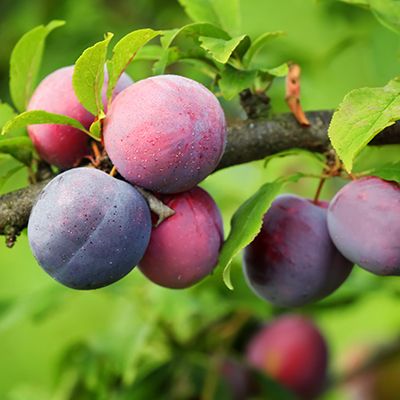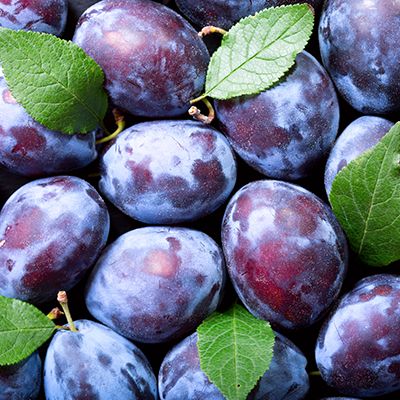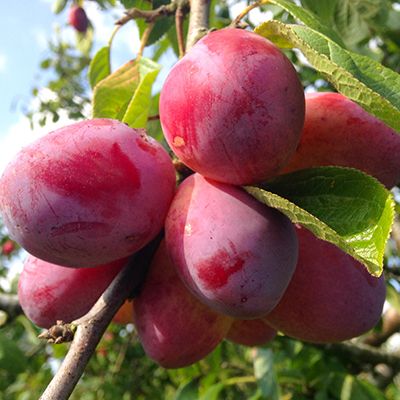


Plum and Prune Trees
Prune
When completely dormant in December or January. European varieties need only a light pruning and thinning. Japanese varieties should have one-quarter to one-half of current season’s growth removed. To identify fruiting wood, see our Fruit Tree Pruning Care Guide. Prune again in late June or early July. Remove the strong, vigorous shoots from the interior of the canopy to improve light penetration and air circulation.
Spray
Dormant spray in December or January after pruning with Master Nursery® Pest-Fighter Year-Round Spray Oil and Liqui-Cop. Mix at the rate of four tablespoons of Monterey Liqui-Cop® with six tablespoons of Horticultural Oil in one gallon of water. The copper product must contain at least 30% copper.
Always check with your nursery professional to properly diagnose problems
before undertaking additional sprays.
Shot hole
Spraying: Spray trees again with Monterey Liqui-Cop® at pink bud and again at full bloom stage if shot hole fungus was present last year.
Pruning: Prune to allow good ventilation.
Sanitation: Remove and destroy affected buds and blossoms during bloom. Remove and destroy maturing fruit when symptoms appear. In August or September, remove and destroy mummies and fallen fruit. Do not compost.
Irrigation Methods: Use basin or drip irrigation to avoid wetting blossoms, foliage and fruit.
Brown rot or blossom blight (different names for the same disease)
Brown Rot is the most common and serious blossom and fruit disease of stone fruits. The first symptom is the browning and wilting of blossoms which may cling to the twigs for a long time. Cankers (sunken brown areas often develop at the base of the infected flowers. Sticky amber colored gum oozes from the base of the flowers or from the cankers. Prune and remove all diseased parts. The dormant season spray of Horticultural Oil and Monterey Liqui-Cop® should control the disease.
Bacterial canker, bacterial gummosis, or bacterial blast (different names for the same disease.)
Common and deadly and caused by Pseudomonas syringae. During the Fall, Winter and Spring, the thin bark of young trees may appear nearly black and a clear, resinous gum exudes from cankers. In older trees, gumming may exude from many areas of the bark and extend up into the small branches often killing them. Splashing rain spreads the bacteria to dormant buds, twigs and branches. Infected blossoms turn brown and wilt; some leaf and flower buds may die. Other branches may fail to produce foliage and later die. The best treatment is to spray the entire tree with Monterey Liqui-Cop® with four tablespoons per gallon of water while it is dormant. Otherwise, removal of infected wood and flowers is the only treatment. Sanitation: Remove and destroy infected buds and blossoms during bloom. Remove and destroy maturing fruit when symptoms appear. In August or September, remove and destroy mummies and fallen fruit. Do not compost.
Aphids
Symptom: Curly Leaves
Spray: Watch for aphids when new leaves are one-half to one inch long. Spray with Malathion or Sevin. Less toxic sprays include Safer® Insect Killing Soap and Monterey Take Down Garden Spray. Use Master Nursery® Pest-Fighter Year-Round Oil as a dormant spray only, as described above under "Spray."
Beneficial insects
Set out Ladybugs, Lacewings or Praying Manti through the summer. Best when yard has nectar-producing flowers which attract adults to stay in area. Soldier beetles will appear naturally to feed on aphids.
Fertilize
Use Master Nursery Fruit Tree & Vine Food twice a year, around Memorial Day and Labor Day. If you prefer organic fertilizers, use Gardner & Bloome® Citrus & Fruit Tree Fertilizer two to three weeks earlier. Water in immediately after application. Supplement organic fertilizers with Iron Sulfate to prevent chlorosis. Apply within two feet of both sides of the drip line of the tree.
Water
At planting, construct a soil berm at the drip line of the tree. As the tree matures, extend the berm to the span of the drip line. Flood weekly during the first year and then at two to four-week intervals when the tree is mature. If a drip system is used, place hosing along the tree’s drip line with emitters on 18 inch centers.
This system will also need to be adjusted as the drip line expands. Both flood and drip irrigation is preferable to sprinklers, since they reduce water splash, a common byway of fungal spores. If sprinklers must be used, adjust heads so that they angle water low and away from the trunk. Keep in mind that a large, mature tree may consume up to 30 gallons of water per week in July and August and September.
Fruit thinning
When fruit reaches about one-half to three-quarters of an inch in diameter, thin to about four inches apart.
Other comments
Many Plums are not self-fruitful and require a pollenizer to ensure good crops. Check with one of Wegman’s staff to determine your needs.
Oozing of clear sap or gum from branches is usually harmless, but amber-colored gum on twigs and tree trunks may indicate the presence of borers or fungus. Bring several leaf and twig samples to Wegman’s Nursery for evaluation whenever these or other symptoms appear.
To prevent sunburn injury and to reduce borer infestations, paint trunks and lower branches of young trees with a one to one mixture of white interior latex paint and water. Apply the paint mixture from two inches below the soil surface to three feet above or to the first scaffold branches.
Adapted from Ogawa and English (1991), Diseases of Temperate Zone Tree Fruit & Nut Crops, UC Extension Publication 3345 and Flint (1998), Pests of the Garden and Small Farm, 2nd Ed., UC Extension Publication 3332.